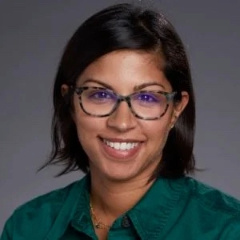 Shoba Ramanadhan, Associate Professor of Social and Behavioral Sciences (HSPH), creates curricular experiences that highlight community partnerships and incorporates diverse student experiences for shared knowledge building in the classroom and within the community. To do this, Ramanadhan integrates principles of Community-Based Participatory Research (CBPR) into her teaching methodology—an approach that includes collaboration with community partners on research design and implementation. Bringing this style of research into the classroom models critical practices of partnership and setting shared goals in collaborative work. As part of this, students are encouraged to share their experiences, especially practice-based expertise from their public health backgrounds. This allows students to learn how they might work within communities based on the experience of peers and community members, rather than just the expertise of the instructor. This informs classroom discussions when approaching a public health research topic. This approach has been transformative for students: “When I started this work about 19 years ago, I had to learn about what a community-based organization practitioner’s day actually looks like, how their organizational structure works, how poorly paid they are. And so, to me, the teaching is really understanding what you don't know and who you can ask, filling those gaps, so that you can be better equipped to be useful to the community you’re working with.”
Shoba Ramanadhan, Associate Professor of Social and Behavioral Sciences (HSPH), creates curricular experiences that highlight community partnerships and incorporates diverse student experiences for shared knowledge building in the classroom and within the community. To do this, Ramanadhan integrates principles of Community-Based Participatory Research (CBPR) into her teaching methodology—an approach that includes collaboration with community partners on research design and implementation. Bringing this style of research into the classroom models critical practices of partnership and setting shared goals in collaborative work. As part of this, students are encouraged to share their experiences, especially practice-based expertise from their public health backgrounds. This allows students to learn how they might work within communities based on the experience of peers and community members, rather than just the expertise of the instructor. This informs classroom discussions when approaching a public health research topic. This approach has been transformative for students: “When I started this work about 19 years ago, I had to learn about what a community-based organization practitioner’s day actually looks like, how their organizational structure works, how poorly paid they are. And so, to me, the teaching is really understanding what you don't know and who you can ask, filling those gaps, so that you can be better equipped to be useful to the community you’re working with.”
Preparing students to meaningfully engage with and learn from community experts
The benefits
Drawing in community expertise and perspectives helps students recognize how their real-world practice can be more impactful with community participation and knowledge co-production. “I really try to emphasize team-based skills because that’s how you actually get it done.” Further, this enables Ramanadhan’s students to develop a better sense of their strengths, as well as a sense of humility.
“It’s really easy to come up with top-down, expert driven, solutions. Part of the beauty of CBPR is the challenge of engaging with the community with humility to understand process, perspective, and implementation, and in ways that draw out expertise and insight wherever it might live.”
The challenges
Because of the nature of the work that Ramanadhan and her colleagues do with communities, relationship building and maintenance are key. Community-led research requires long-term commitment, which most courses can’t accommodate. Because her courses run for eight weeks and have other primary foci, she brings in examples of engagement and diverse expertise and supports students with community engagement outside of the class. Ramanadhan and her team sometimes take on students as interns in their own research as a way to offer an entry point into research opportunities in the community.
Takeaways and best practices
-
Model collaboration and growth.
Ramanadhan makes a point to be open with her students about her own growth as a researcher to combat their hesitation to collaborate with peers or communities and their fears of making a mistake or appearing incapable. “Everyone is learning and working together toward change. It does not need to be a competition.” -
Critique the evidence.
When doing community-based and participatory research, Ramanadhan encourages students to question assumptions that can lay behind knowledge. This can be particularly helpful with initiatives related to framing existing research as in the proper context: “This is knowledge and it’s useful, but it’s probably only just one part of the picture.” -
Draw out student voices.
"We are all learners, and we are all experts." From the first day of classes to the last, Ramanadhan brings students' expertise and experience to the forefront, just as one would when working with community partners. This is more than just discussion because it is grounded in CBPR as a practice that emphasizes diverse sources of expertise. “I spent a lot of time doing things like introductions and what might seem like icebreakers, but really draw out ‘Where have you been, and what do you know that the rest of us would love to benefit from?’”
Bottom line
Centering practical applications that draw in community-based perspectives can challenge field norms as well as foster an inclusive learning environment that builds student strengths and a sense of humility.
